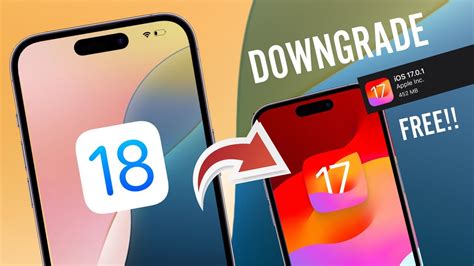How to Downgrade iOS 18 to iOS 17: A Comprehensive Guide
Are you experiencing issues with iOS 18? Many users find that a new iOS release brings unexpected bugs or performance problems. If you've upgraded to iOS 18 and are unhappy with it, you might be looking to downgrade back to the stability and familiarity of iOS 17. Unfortunately, directly downgrading iOS isn't officially supported by Apple. However, there are methods you can try, but proceed with caution as these methods involve technical steps and carry risks.
Understanding the Challenges of Downgrading iOS
Before we delve into the potential methods, it's crucial to understand the limitations:
- Apple's Approach: Apple doesn't provide an official tool to downgrade iOS versions. Once you've upgraded, Apple generally closes the signing window for the previous version, making a direct downgrade impossible.
- Time Sensitivity: The window of opportunity to downgrade is short. Apple only keeps older iOS versions signed for a limited time after releasing a new update. Once the signing window closes, downgrading becomes extremely difficult, if not impossible.
- Data Loss Risk: Any method attempting to downgrade iOS carries the inherent risk of data loss. Always back up your device before attempting any downgrade process.
Potential (Unofficial) Methods & Their Risks
While there are no guaranteed methods for downgrading after Apple closes the signing window, some users explore unofficial tools and techniques. These methods are generally complex, require technical knowledge, and can potentially damage your device.
Warning: These methods are not officially supported and are performed at your own risk. Incorrect execution could lead to a bricked device, requiring professional repair.
Method 1: Using Third-Party Tools (Highly Risky)
Some third-party tools claim to offer iOS downgrade capabilities. However, these tools are often unreliable, may contain malware, and can seriously damage your iPhone or iPad. Proceed with extreme caution, and only use well-vetted tools (if you find any) from trusted sources. Even then, the success rate is low, and the risk is high.
Method 2: Restoring via iTunes/Finder (Limited Success)
If the signing window for iOS 17 is still open (check this immediately!), you might be able to downgrade by restoring your device using iTunes (for older macOS versions) or Finder (macOS Catalina and later) with a valid iOS 17 IPSW firmware file. This requires finding the correct IPSW file online, and the process is intricate. This method only works if Apple's servers still allow it.
Before You Begin ANY Downgrade Attempt
- Back up your data! This is crucial. Use iCloud or iTunes/Finder to create a full backup. A failed downgrade could result in permanent data loss.
- Research thoroughly: Understand the specific steps involved in any method you consider. Watch videos and read tutorials carefully.
- Proceed at your own risk: You are solely responsible for any damage to your device.
The Best Approach: Preventing Future Downgrade Needs
Instead of attempting a risky downgrade, consider these preventative measures:
- Research the new iOS version: Read reviews and articles before upgrading to be aware of potential issues.
- Wait before upgrading: Allow time for Apple to release updates addressing initial bugs.
- Consider beta programs cautiously: While beta programs offer early access, they're often unstable.
Downgrading iOS is a complex and risky process. Unless you're highly technically proficient and fully understand the risks, it's generally best to avoid attempting a downgrade and instead focus on prevention or accepting the current iOS version. Remember, data loss is a very real possibility.
